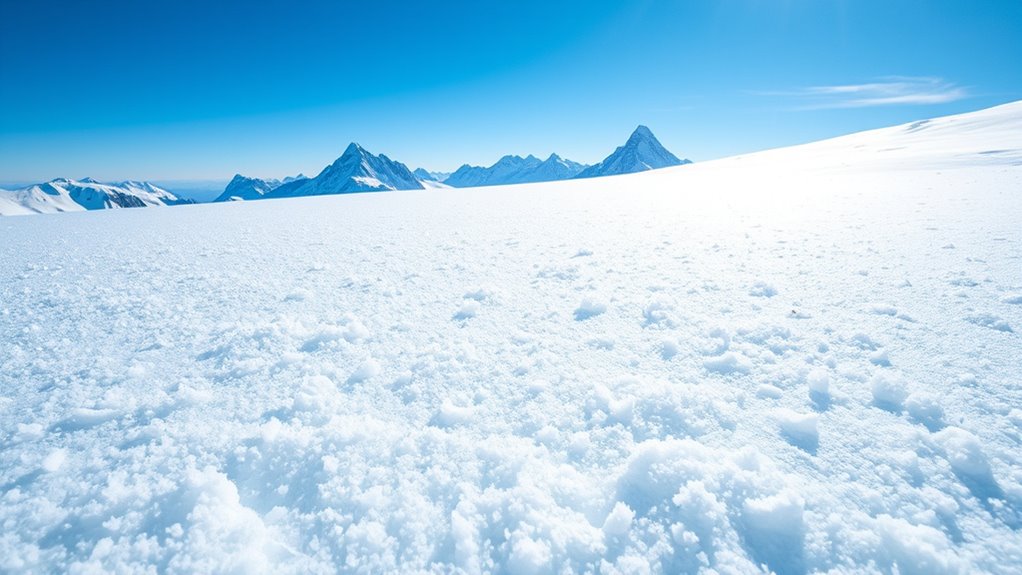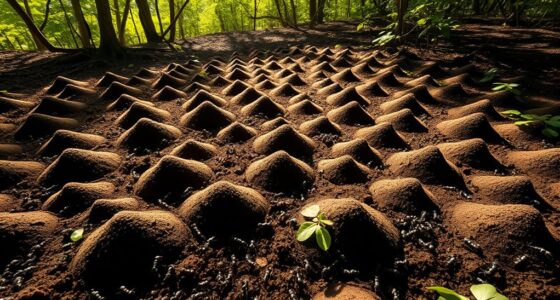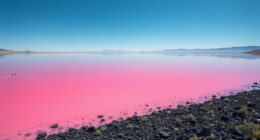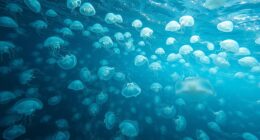Microplastics seep into mountain snow from distant pollution sources like urban areas, industrial activities, and airborne transport. Wind carries these tiny particles hundreds of miles, depositing them into remote alpine regions where snow captures and temporarily stores them. As snow melts, the microplastics are released into glaciers, streams, and ecosystems, affecting wildlife and human water supplies. If you’re curious, you’ll discover how this global cycle connects pollution from afar to pristine mountain environments.
Key Takeaways
- Microplastics originate from diverse sources like personal care, textiles, and waste, dispersing into mountain atmospheres via wind.
- Atmospheric currents carry microplastics over long distances, depositing them into remote mountain snowpacks.
- Snow acts as a temporary reservoir, capturing microplastics that later melt and release pollutants into ecosystems.
- Melting snow introduces microplastics into water systems, impacting wildlife and potentially entering the human food chain.
- Addressing this cycle requires global efforts to reduce plastic waste and emissions, as pollution spreads internationally.

As snowfall blankets mountain regions, tiny microplastics often hitch a ride on the wind and in the atmosphere, making their way into even the most remote alpine environments. You might think these pristine areas are untouched by human waste, but pollution sources like distant urban centers, industrial activities, and transportation emissions send microplastics airborne. These particles are lightweight enough to travel hundreds of miles, carried by atmospheric currents that deposit them into snowpack. Once in the snow, microplastics become part of a hidden cycle, contaminating the mountain’s water reserves and ecosystems.
The process begins with pollution sources that release microplastics into the environment. These include microbeads from personal care products, synthetic fibers from textiles, and degraded plastic debris from landfills and waste sites. Wind disperses these tiny particles into the atmosphere, where they can linger for days or weeks before settling. When snow falls in these regions, it captures microplastics along with other atmospheric particles, leading to snowpack contamination. This contamination isn’t just a surface issue; microplastics become embedded within the snow layers, making their way into melting glaciers and streams as temperatures rise.
You need to understand that snowpack acts as a temporary storage unit for microplastics, slowly releasing them into downstream ecosystems as it melts. This process means mountain environments are not isolated from pollution but are integral parts of a broader global cycle. Microplastics in snow can enter the soil and water systems, impacting wildlife and potentially entering the human food chain through drinking water and locally sourced food. As snow melts, it releases these particles into rivers, lakes, and groundwater, spreading contamination far beyond the mountain’s base.
The infiltration of microplastics into snowpack also complicates efforts to monitor pollution. It’s difficult to trace the exact sources because airborne microplastics originate from diverse pollution sources across vast areas. This widespread dispersal underscores the interconnectedness of pollution and highlights the mountain regions’ vulnerability. You may be surprised to learn that even wind-blown debris from distant cities can profoundly impact these remote environments, illustrating how pollution sources have far-reaching effects.
In essence, snowpack contamination from microplastics reveals a complex, ongoing cycle driven by pollution sources far from the mountains themselves. It emphasizes the importance of addressing plastic waste and emissions globally, as these tiny particles threaten the integrity of pristine alpine ecosystems. Your awareness and actions can contribute to reducing this invisible contamination, helping safeguard mountain environments for future generations.
Frequently Asked Questions
How Do Microplastics Affect Mountain Ecosystems Long-Term?
You might wonder how microplastics impact mountain ecosystems long-term. They cause soil contamination, which can hinder plant growth and disrupt nutrient cycles. Wildlife health also suffers as animals ingest or get entangled in plastics, leading to injuries or death. Over time, these effects can weaken ecosystem resilience, alter food webs, and reduce biodiversity, ultimately threatening the balance and health of mountain environments you rely on and enjoy.
Can Microplastics in Snow Impact Drinking Water Sources?
Imagine pristine mountain snow melting into your drinking water, but embedded within are tiny microplastics. These particles can bioaccumulate as they pass through snowpack filtration, gradually contaminating water sources. When the snow melts, microplastics seep into streams and reservoirs, risking your health. You might unknowingly consume microplastic-laden water, highlighting the pressing need to address these invisible pollutants and protect your drinking water from long-term contamination.
What Are the Main Sources of Microplastics Reaching Mountain Snow?
You should know that microplastics reach mountain snow mainly through atmospheric deposition and urban runoff. When you observe pollution, tiny plastic particles are carried by wind and settle in remote areas. Urban runoff from cities carries plastics from roads, waste, and industrial sources, which then find their way into mountain environments. These processes introduce microplastics into snow, creating a new cycle that impacts ecosystems and water sources.
How Do Microplastics in Snow Compare to Those in Oceans?
Microplastics in snow and oceans differ mainly in their environments and contamination pathways. You’ll find microplastic sources in ocean waters from plastic waste, while snow contamination pathways involve airborne particles settling on mountain peaks. Snow acts like a snapshot of atmospheric pollution, capturing microplastics from diverse sources. Though concentrations vary, both environments reveal the pervasive reach of microplastics, highlighting the need for detailed cleanup and conservation efforts.
Are Certain Mountain Ranges More Vulnerable to Microplastic Pollution?
You might notice that certain mountain ranges are more vulnerable to microplastic pollution due to their elevation gradients and ongoing glacial retreat. Higher elevations can trap airborne microplastics, while melting glaciers release accumulated particles into downstream environments. As glaciers retreat, they expose new areas to pollution, making these ranges especially susceptible. Your awareness of these factors helps you understand why some mountain regions face greater microplastic contamination risks.
Conclusion
As you peer into the pristine mountain snow, remember it’s become a silent canvas for a global story of microplastics. These tiny particles drift like invisible whispers from distant cities, blending into nature’s icy armor. Your actions ripple through this delicate cycle, turning peaks into unintended trash collectors. By understanding this hidden trail, you hold the power to break the chain, protecting these snowy giants from becoming permanent, frozen reminders of our plastic footprint.









